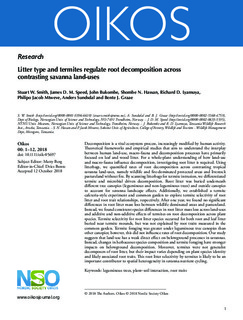| dc.description.abstract | Decomposition is a vital ecosystem process, increasingly modified by human activity. Theoretical frameworks and empirical studies that aim to understand the interplay between human land-use, macro-fauna and decomposition processes have primarily focused on leaf and wood litter. For a whole-plant understanding of how land-use and macro-fauna influence decomposition, investigating root litter is required. Using litterbags, we quantified rates of root decomposition across contrasting tropical savanna land-uses, namely wildlife and fire-dominated protected areas and livestock pastureland without fire. By scanning litterbags for termite intrusion, we differentiated termite and microbial driven decomposition. Root litter was buried underneath different tree canopies (leguminous and non-leguminous trees) and outside canopies to account for savanna landscape effects. Additionally, we established a termite cafeteria-style experiment and common garden to explore termite selectivity of root litter and root trait relationships, respectively. After one year, we found no significant differences in root litter mass loss between wildlife dominated areas and pastureland. Instead, we found consistent species differences in root litter mass loss across land-uses and additive and non-additive effects of termites on root decomposition across plant species. Termite selectivity for root litter species occurred for both root and leaf litter buried near termite mounds, but was not explained by root traits measured in the common garden. Termite foraging was greater under leguminous tree canopies than other canopies; however, this did not influence rates of root decomposition. Our study suggests that land-use has a weak direct effect on belowground processes in savannas. Instead, changes in herbaceous species composition and termite foraging have stronger impacts on belowground decomposition. Moreover, termites were not generalist decomposers of root litter, but their impact varies depending on plant species identity and likely associated root traits. This root litter selectivity by termites is likely to be an important contributor to spatial heterogeneity in savanna nutrient cycling. | nb_NO |
